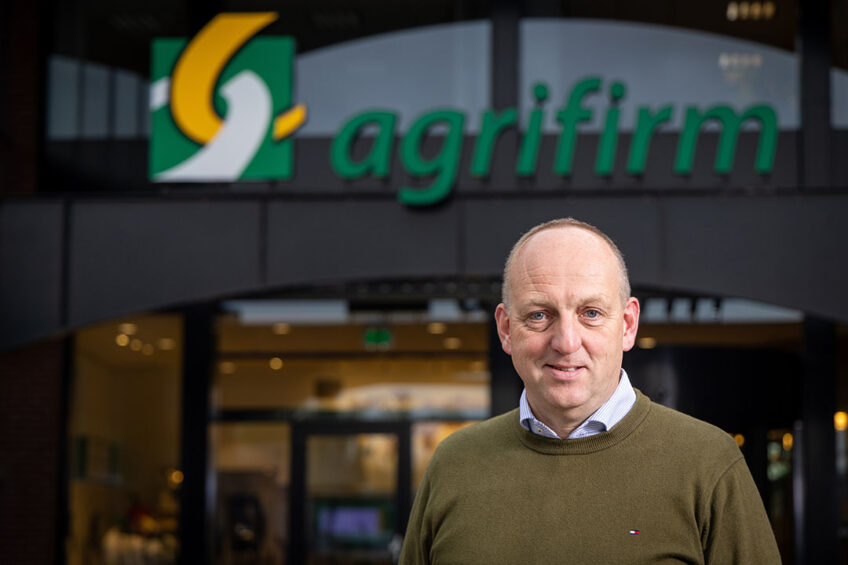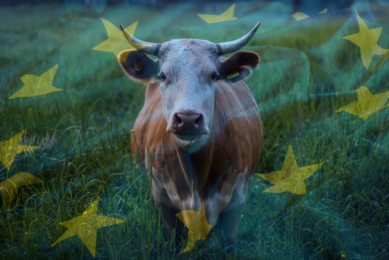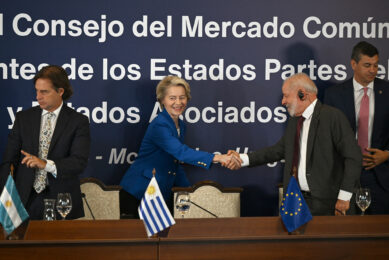Agrifirm’s purchasing head talks about volatility in commodity markets

Commodity markets are becoming increasingly volatile, noted Cornel Boere, head of the purchasing department at Agrifirm. The company looks 2 years ahead when it comes to its purchasing strategy, and has noticed that the risks are increasing. This ‘forces’ partnerships that pay themselves back with extra information and better logistics.
Once the burning Russian wheat fields were on TV, speculation increased market volatility more than ever.
Fluctuating prices for raw materials are not a thing of the past. Cornel Boere has been in the raw material business for 30 years. When he started at Cehave Landbouwbelang at the end of 2007 with 15 years’ experience under his belt, he became responsible for purchasing all the company’s raw materials. He almost immediately faced an upcoming crisis. The market was already uneasy due to the credit crisis, and this was further exacerbated by extreme drought in the grain areas. “Once the burning Russian wheat fields were on TV, speculation increased market volatility more than ever.”
What influence did this market volatility have?
“The extreme price movements caused suppliers to go bankrupt. Raw materials that were on the books were not delivered. If you must explain to farmers why feed prices are suddenly skyrocketing or why feed cannot be supplied, you are in trouble. That is what makes volatile markets so dangerous, and why we choose partners who can take a few blows.”
Agrifirm sells more than 4 million tons of feed and premixes. How do you purchase such large volumes?
“We have a broad horizon. We always look 1 to 2 years ahead at how markets will develop. The sales department provides us with expectations of how much of which feeds they will sell and in which market. From this, we can deduce what we need in terms of grains, proteins, amino acids, and vitamins. The mutual price ratios determine whether the use is corn, wheat, soy, turnip, syrup, citrus or any other raw material.”
The first thing you mention is ‘how markets will develop’.
“To be more exact: what are the harvest expectations? These are very decisive. We have continuous insight into the expected usage, areas, yields and price ratios. With a very experienced group of buyers, almost 30 people, we have a wealth of knowledge.”
With a 2-year window into the future you are talking about prices for grain that has yet to be sown
“It is not directly about the price, but about the supply. High prices lead to high production and therefore lower prices. This applies to grains, less so to protein crops. If a few percent more or less grain becomes available, we want to know about it. So not only: what does it look like now, but above all, what will happen in the next year and perhaps even the year after that? This is how we determine our purchasing strategy. With premixes, we must do business in countries that are sensitive to economic fluctuations, political unrest, uprisings, or war. Then things can suddenly turn out very differently than expected.”
The price is not formed by taking the last cent out of the price negotiations.
Does a 2-year window also mean committing to delivery within that period?
“Not immediately; that depends on the price. We are not a trading firm, but we purchase raw materials for our own use. This gives us a different relationship with our suppliers because they know that if Agrifirm buys, we also purchase. We buy portions every time, most people in this business do. With our size, suppliers sometimes do not even want to sell to us at once, because they also take a risk. If we were to buy 200,000 tons of wheat at once, the supplier would have to purchase it from farmers or have it in their barns.”
Surely the big suppliers of this world can handle that?
“Yes, but they do not have much in stock either. They purchase the raw materials and hedge this with financial instruments. However, the spreads and price differences between futures markets such as Matif and CBOT with the effective delivery are increasing. This in turn increases the risks because we are not that supplier’s only customer. Then, the risks just keep adding up.”
Isn’t that a prelude to consolidation?
“Yes, and that is also in full swing. Around 2005, there were still many local traders, grain collectors and importers of specific raw materials. Many people suffered a major blow in the credit crisis and since then the number of parties has been decreasing. That process will accelerate in the coming years. I even foresee that large players will cluster or will be acquired. Look at, for example, where Viterra and Cofco now stand. They have attracted many companies. The number of parties we do business with is decreasing.”
External factors in particular lead to price volatility.
Is that an opportunity or a threat?
“For me, the glass is always half full. Consolidation also offers opportunities. You can make purchasing agreements with large parties and, in addition to price, there are a number of themes that are becoming more important. Think of sustainable purchasing, and the new EUDR that combats deforestation. It is much more difficult for a small importer to organise this than for large companies such as Cargill, Bunge, or ADM. They are willing to invest in it. And of course, not only the number of providers decreases. The number of purchasing parties has also decreased significantly. This leads to more stable prices or more stable margins in the chain.”
It can also lead to more tensions.
“External factors in particular lead to price volatility. See what happened with the Ukraine crisis, with corona and the Evergreen that was stuck in the Suez Canal 2 years ago. With logical reasoning and knowledge of global acreage, we know how many raw materials will become available and you can calculate the approximate price. Now suddenly, factors are being added from all kinds of directions. The price swing is getting larger. That is why we never buy everything we directly need at once. We are certainly not speculators; we always make a choice based on analyses. Do we run zero risk? No. We take business risks. To what extent, that is determined by our management.”
Should you act differently when prices are high versus low?
“Very high prices cannot be sustained. With wheat at €400 per ton, the purchasing strategy is different than when the wheat price is €120. But even then, we do not buy 5 years in advance. Because who says that in 5 years as much grain will be needed as now? Then we come back to the horizon in which you act.”
Who decides in periods of extreme volatility?
“Initially, the purchasing team does. As soon as prices exceed bandwidths, I present our proposals with all pluses and minuses to our management team. At the beginning of the Ukraine war, we met every morning for weeks to discuss what to do. At that time, in addition to the price, the physical availability of grain was the main issue. We have a duty to supply food to our members. Then we sometimes must accept a price to guarantee that we can continue to supply feed. A dairy farmer can always do a lot with his own feed, but for a broiler farmer the animals are dead in the stable after 5 hours without feed. That is precisely why we are doing more business with large parties to have that supply certainty.”
To what extent do you structurally do business with the same parties?
“We are all about partnerships and building long-term relationships. In a partnership, companies are prepared to share information that is not always available in the market. This is particularly important to us, given our size and the risks we run. The price is not formed by taking the last cent out of the price negotiations. Suppose wheat is €225 and they have information that a stock report will be released tomorrow that will cause that price to drop €5. The fact that they share that information is more important than a few cents of benefit the day before.”
Are there more benefits to partnerships?
“Of course. Even though we are a cooperative with a healthy financial system, we are also reaching the limits of our working capital. Especially now that interest rates are rising, we want to have as few stocks as possible in our chain that we have to pre-finance for 6 weeks. We want to have a supply every day. We cannot arrange that ourselves, those vessels do not arrive in Rotterdam with raw materials every day. So, we must buffer a bit. In a partnership, we can jointly look at how to arrange the optimal stock for both the supplier and for us. This is possible if we want to make clear agreements and divide the benefits. That is why we have our own barges in the Netherlands and Belgium. We can leave larger volumes on the water for a while. We move it between factories.”
Would you rather not do business with very small suppliers?
“We do not need thousands of raw materials. There are some big flows and a whole bunch of pinches, sniffs, and sours. For the large flows that come from overseas, only the major players have the logistics chain that is so important to us. For the other flows, we will certainly still do business with smaller parties, because they sometimes have very distinctive products. Think of Faba beans. These are not commonly available at major players. Sometimes, small players apply a special treatment, which makes it much more attractive for us to buy it from them.”
Where do these consolidations end?
“Good question. I cannot estimate where that process ends. I also did not think that Bunge and Viterra would merge already. I can also not rule out that it will go further. A number of flows such as amino acids, vitamins and some specific ingredients are almost exclusively produced in Asia. Then geopolitics can come into play. The Americans are really preparing for that.”
I am convinced that we will never go back to the very low price level of about 10 years ago.
With a horizon of 1 to 2 years, you can probably indicate what the feed price will be in 6 months’ time?
“I cannot quote a feed price. I do know what the market is like. Because corn comes from the field relatively early, it is already putting pressure on the market. Grain prices will now drop to their lowest point, then they will rise again. We can also see this in the price formation, the January price for grains is higher than it is now. In addition, there appears to be a very good soy harvest in South America. That could put some pressure on protein prices. This provides a counterbalance to the increase in grain prices from January. I mean the prices in dollars. If the dollar exchange rate remains around the current 1.05, feed prices will remain stable until May. Then, the impact on how well the sowing of soy is going in South America will be felt.”
Are feed prices structurally higher now or will they return to much lower levels?
“I am convinced that we will never go back to the very low price level of about 10 years ago. An entire biofuel industry has emerged that also requires raw materials. A quarter of the American corn is already being processed into bioethanol. The price level now seems high, but it is not too bad. If the inflation remains 10% for 2 years instead of almost 0%, it will be difficult for wheat to fall below €200. Perhaps the new normal for wheat is €240.”
There are more and more chain concepts.
“That makes purchasing more complex. Not all parties can meet the conditions for regional raw materials, non-GMO raw materials or circularity. As a result, we tend, or are forced, towards partnerships. Because we do not make such agreements for 2 months. The price always remains related to what futures markets do, but we become less flexible in terms of logistics and production. Complexity increases and thus efficiency partly disappears from the chain. Chain concepts therefore do not always reduce costs.”











